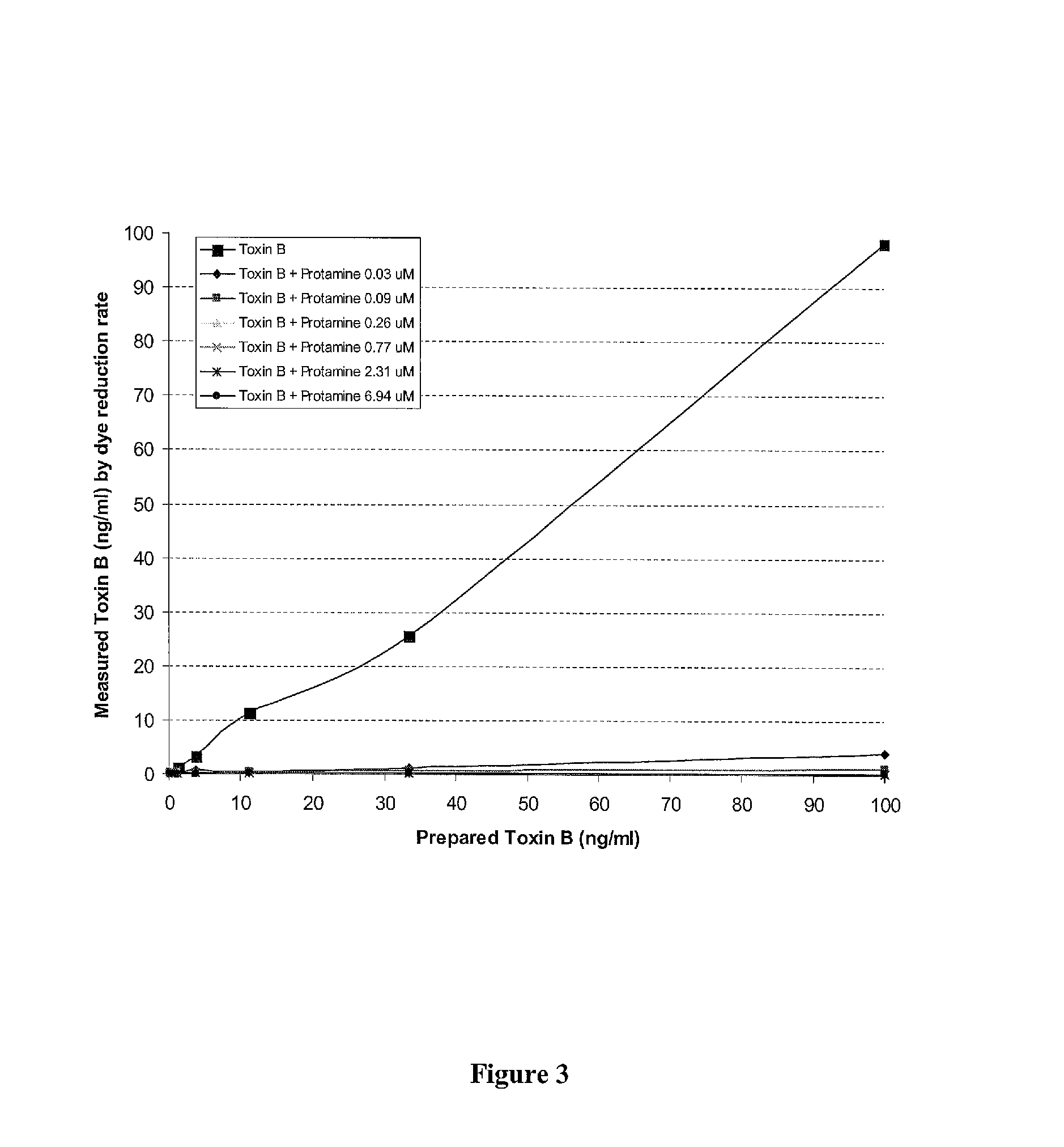Compositions and methods to inactivate and/or reduce production of microbial toxins
a technology of microbial toxins and inactivation methods, applied in the direction of antibacterial agents, drug compositions, peptide/protein ingredients, etc., can solve the problems of tissue and organ damage, death, etc., and achieve the effect of reducing the amount of labeled bounds
- Summary
- Abstract
- Description
- Claims
- Application Information
AI Technical Summary
Benefits of technology
Problems solved by technology
Method used
Image
Examples
example i
Microwell Dye Reduction Metabolic Assay
[0155]This example describes a method to determine cell viability by measuring the reduction in a dye measuring energy substrate utilization. CHO-k1 cell cultures were placed in a standard microwell array (e.g., for example a 12×8 array). Approximately, 20,000 cells / ml were placed in each well containing 50 microliters of an RPMI 1640 assay medium comprising 2 mM glucose, 2 mM glutamine, 2% fetal bovine serum and 0.9% phosphate buffered saline. After twenty-four hours the cells were washed with fresh medium and an aliquot of a commercially available metabolic substrate utilization dye indicator was added (e.g., for example, Biolog Dye Mix MB).
[0156]The assay was initiated by adding Clostridium difficile Toxin B and an inhibitor protein / peptide (e.g. for example, protamine) such that a dose response curve of the inhibitor protein / peptide could be determined at various C. difficile Toxin B concentrations. One example of a microwell array set-up i...
example ii
Protamine Inactivation of C. difficile Toxin B
[0157]CHO-k1 cell culture were used in this cytotoxicity assay in accordance with Example I. C. difficile toxin B at concentrations of 100 ng / ml, 33.3 ng / ml, 11.1 ng / ml, 3.7 ng / ml and 1.2 ng / ml were added to the cell culture followed immediately by protamine sulfate in 3-fold dilutions.
[0158]The cells were then incubated in CO2 incubator at 37° C. for 20 hrs. Biolog Dye Mix MB was added to the cells at the end of the CO2 incubation, which is immediately followed by incubation in Biolog OmniLog instrument at 36° C. for 3 hrs. The dye reduction occurred during the 3 hrs and the signals of dye reduction (color is darker when more dye molecules are reduced by the cells) were recorded automatically by the instrument.
[0159]The healthier the cells are, the higher the dye reduction rate is. Based on regression analysis on the dye reduction rates under various concentrations of the standard toxin B alone (the toxin standard curve), the reduced t...
example iii
Protamine III-2 Peptide Inactivation of C. difficile Toxin B
[0161]CHO-k1 cell culture were used in this cytotoxicity assay in accordance with Example I. C. difficile toxin B at concentrations of 100 ng / ml, 33.3 ng / ml, 11.1 ng / ml, 3.7 ng / ml and 1.2 ng / ml were added to the cell culture followed immediately by protamine III-2 peptide in 3-fold dilutions.
[0162]The cells were then incubated in CO2 incubator at 37° C. for 20 hrs. Biolog Dye Mix MB was added to the cells at the end of the CO2 incubation, which is immediately followed by incubation in Biolog OmniLog instrument at 36° C. for 3 hrs. The dye reduction occurred during the 3 hrs and the signals of dye reduction (color is darker when more dye molecules are reduced by the cells) were recorded automatically by the instrument.
[0163]The healthier the cells are, the higher the dye reduction rate is. Based on regression analysis on the dye reduction rates under various concentrations of the standard toxin B alone (the toxin standard cu...
PUM
| Property | Measurement | Unit |
|---|---|---|
| Antimicrobial properties | aaaaa | aaaaa |
| Mortality rate | aaaaa | aaaaa |
Abstract
Description
Claims
Application Information
 Login to View More
Login to View More - R&D
- Intellectual Property
- Life Sciences
- Materials
- Tech Scout
- Unparalleled Data Quality
- Higher Quality Content
- 60% Fewer Hallucinations
Browse by: Latest US Patents, China's latest patents, Technical Efficacy Thesaurus, Application Domain, Technology Topic, Popular Technical Reports.
© 2025 PatSnap. All rights reserved.Legal|Privacy policy|Modern Slavery Act Transparency Statement|Sitemap|About US| Contact US: help@patsnap.com



